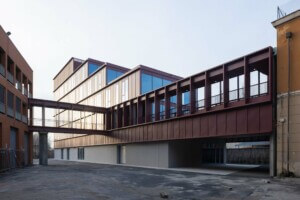A consortium of prominent Italian home furnishing designers and manufacturers are urging Prime Minister Giuseppe Conte to allow their industries to resume production ahead of the country’s gradual re-opening, which is now slated to begin May 3 at the earliest but could likely be pushed back. Italy’s famed and economically vital home design industry—largely centered around Milan but spread across the country—has been at a virtual standstill since at least March 22, when production at the country’s non-essential factories was halted due to the global coronavirus crisis. Italy, an early epicenter of the pandemic, went into nationwide lockdown mode earlier in the month, on March 9.
The group, which includes modern furniture company B&B Italia, high-end mosaic tile producer Bisazza, kitchen and bathroom heavyweight Boffi, home furnishings company Cappellini, luxury furniture manufacturer Cassina, family-owned furniture producer Flexform, furniture designer Giorgetti, furnishings company Molteni Group, and handcrafted leather furniture-maker Poltrona Frau, have published a Design Manifesto circulating with the declarative hashtag #DesignDoesntGiveUp that lays out their collective concerns and objectives moving forward.
Published on April 8, the document, one that’s both pragmatic and rather poignant in tone, suggests that the government allow furniture production to gradually resume starting on April 14 (a timeframe that’s obviously since passed) to avoid certain “economic catastrophe.” The four-page letter, which was signed by the heads of each of the aforementioned companies, reads:
“Today, furniture and design companies are asking to be able to begin a progressive and safe reopening process from the 14th of April. It is our workforce who ask us, together with customers from all over the world with whom we are in constant daily contact. The factories are ready and safe, the rules clear and perfectly enforceable. Financial aids and measures for credit are important but if production does not start we will no longer have companies that are able to take those measures once available.”
The letter notes that opening showrooms and stores “soon” is also crucial to the industry’s long-term health.
In addition to stressing concerns about allowing the production shutdown to drag on further, the manifesto elaborates on what the industry has done thus far during the pandemic to maintain a sense of normalcy and keep some level of non-production operations humming. It mentions the “extraordinary spirit and availability to work from home” of its employees, who are “demonstrating the great spirit of sacrifice and maintaining a very high standard of efficiency.”
“Great effort is made every day to make us feel close to our many employees around the world, often in ‘smart working’ mode, and to our customers and the large community of architects and designers. To keep this great family together with the right warmth is the best guarantee to ensure a prompt recovery as soon as we can all start again.”
The Design Manifesto also mentions that many companies have opted to voluntarily to reduce the salaries of senior management teams to counterbalance the losses experienced by their greater workforces. “We are really proud of this gesture which tangibly demonstrates one of the secrets of these strong Italian companies: in great challenges we pull together.”
The signatories also stress that if and when production does resume, safety will be paramount and that the inherent nature of their manufacturing operations—“very large shop floors with a small and distributed influx of people”—allows for the appropriate precautions to be taken, and that the risk of overcrowding is “practically nonexistent.”
The letter notes that, among other measures, cafeterias and other communal areas at facilities would be initially closed to workers who would instead take meals individually. Masks and other protective gear would be widely available and other already stringent safety precautions would be bolstered. The temperatures of workers would also be potentially taken with thermal scanners. The industry leaders also point out that a majority of Italy’s furniture factories are located in suburban areas that are easily accessible by private car, foot, or bicycle, eliminating the need for workers to take public transportation where the risk of exposure to the coronavirus is greater.
“When workers go to the factory today, they know that they are entering a controlled and safe place such as, and perhaps even more than, their home or the supermarket where they shop regularly.”
Lastly, the manifesto emphasizes the vital role the furniture and design industry plays in the overall economic engine of Italy as “one of three strategic sectors of Italian production” that employees over 130,000 people distributed between 20,000 active companies. It points out that the longer Italian production facilities remain shuttered, the further an upper hand will be granted to the design and furnishing industries of competitive European markets where production is continuing apace, namely in Germany and in Scandinavian countries.
“Solicited by large developers or international customers, they can certainly guarantee production and delivery times by obtaining commissions and orders that would have otherwise been ours.
Their products will first take our place in projects that cannot be postponed over time, then perhaps even in multi-brand stores around the world. Thousands of orders would be lost or cancelled. The recovery, when it occurs, will be characterised by a very low backlog and a severely deteriorated financial situation.
For many companies in the sector, this would mean that they would no longer be able to open again. We could lose 20 to 30 percent of our industrial heritage and witness serious damage to the industry. All of this would inevitably result in the loss of tens of thousands of jobs. It could take 20-30 years to recover what we would lose in a few weeks.”
The Design Manifesto concludes: “… it is to our craftsmen, workers, office employees and managers that we dedicate our utmost effort to be able to reopen and start again stronger than before, in the knowledge that only united we can continue to thrive in the time to come.”











